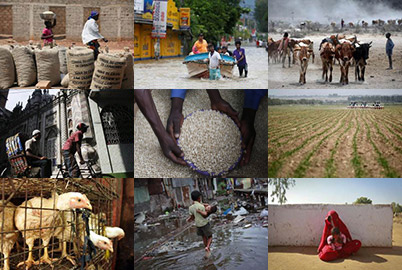Northeastern Uganda's Karamojong people - a semi-nomadic tribe who make their living from cattle herding - look at the stars to work out the flux of the wet and dry seasons. And when warm weather comes early, they know that if it isn't followed by heavy rains, their crops will fail and they'll face hunger.
"I wish the government would use these indicators to prepare relief instead of just relying on satellite imagery," said David Pulkol, a Karamojong community leader and former Ugandan government minister, at a press conference in London last week.
Pulkol was speaking at the launch of a report by Minority Rights Group International (MRG) which said that indigenous and minority communities frequently bear the brunt of climate change, but often come last on the aid list because they're on the margins of society.
In the semi-arid and impoverished Karamojong region - which is roughly the same size as Belgium - the lack of interaction between the state and informal authorities is a hindrance in dealing with climate-related emergencies like droughts, according to Pulkol.
The Karamojong see government officials as rural tourists, popping into villages for a couple of hours to be told only what they want to hear, Pulkol said. For help, local people turn to tribal elders instead, who dispense essential advice about matters like the right time to set fire to grasslands.
This type of knowledge is invaluable to people's livelihoods. But at the same time it's under threat as climate change is expected to bring new weather patterns that could overwhelm communities' capacity to cope.
In Karamoja, locals say the region's rainy months have shortened from six to four. Three droughts in the past six years have pushed people to the limit, and violence is on the rise as more armed herders resort to cattle-raiding.
"Climate change is wiping out our knowledge base and destroying the life of our community," said Pulkol. "There is no integration of indigenous knowledge into development planning, and so people are becoming more powerless."
Pulkol echoes a growing chorus of experts urging greater integration of traditional and scientific knowledge in efforts to help vulnerable communities tackle climate change.
This week, the International Union for Conservation of Nature (IUCN) released a report arguing that indigenous peoples around the world may suffer most from climate change due to a combination of their high dependence on ecosystems, occupation of marginal lands, social pressure and lack of political representation. But it stresses that they're not just victims.
"Because of their long dependence on nature they've developed strategies to cope with climate change and extreme natural events which still have as much relevance today as they did hundreds of years ago," said Director General Julia Marton-Lefèvre in a statement.
The report features the remote Honduran village of Guarita, where farmers use traditional Quezungal methods to protect their crops, including terracing and planting crops under trees so that the roots anchor the soil. When Hurricane Mitch hit in 1998, only 10 percent of crops were lost, while other regions were devastated.
The village's success has been promoted by the government and United Nations, with the techniques being used as a starting point for climate change adaptation, according to the report.
Another example cited is Bolivia, where Aymaran indigenous peoples have coped with water insecurity and scarcity for centuries by building small dams (qhuthanas) to harvest rainwater in the mountains and pampas. This system is essential for the survival of both humans and livestock in times of drought, and the reservoirs also help regulate humidity.
Other types of traditional and innovative practices include reinforcing shorelines, using new materials and building technologies, changing hunting practices, trying out different crops and ways of making a living, and developing measures to reduce the risk of disasters.
These methods of coping with extreme weather - and in the longer term, climate change - are effective and relatively cheap. What's more, they preserve cultures and local people's dignity. The main problem is that they're not given much weight at national and international level.
The IUCN report says most international climate change policy documents hardly recognise traditional and indigenous coping strategies. This needs to be rectified, not least because traditional and indigenous peoples "may have valuable lessons to offer about successful and unsuccessful adaptations which could be vital in the context of climate change", it says.
In addition, it recommends that these communities must be actively involved in policy making at all levels, from local to international.
MRG, meanwhile, is calling on governments to consult minorities in drawing up national programmes of action for adapting to climate change (NAPAs) - formal documents that help poor countries address their immediate needs and access international funding. So far, this hasn't happened.
"Without political clout, minorities and indigenous groups are so much more vulnerable," said Ishbel Matheson, MRG's head of policy and communications. "Their voices must be heard within the blizzard of policy making that is going on at the moment."
Our Standards: The Thomson Reuters Trust Principles.

